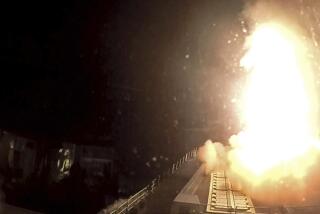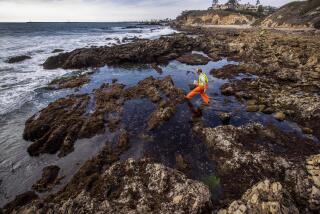Officials Float Plan for Handling More Tankers in Overcrowded Bosporus
- Share via
ISTANBUL, Turkey — A Greek oil tanker looms out of the afternoon haze, lumbering through a haphazard flotilla of private boats. A small ferry cuts across its bow. Another slices toward the behemoth, waiting for it to pass.
The Bosporus, one of the world’s most crowded and chaotic waterways, teems with boat life while bisecting Istanbul, an ancient Turkish city of 9 million people.
Collisions and groundings already are all too common. Now that major oil discoveries around the Caspian Sea raise the prospect of even more tanker traffic, many Turks are worried.
The government is considering new rules for Bosporus traffic that would require more notice from cargo ships. But those rules also would, for the first time, allow vessels to pass during bad weather as long as local pilots help navigate the strait’s tricky currents and narrow confines. An electronic tracking system and new rescue stations also would be built.
The country’s traditional antagonists--Russia and Greece--and others that would benefit from the new oil trade chafe at limits to the only waterway connecting the Black Sea and the Mediterranean.
The Turks answer that more regulation is necessary to improve safety.
“What about the 5,000-year-old cultural buildings of the city, the population, nature?” says Yilmaz Dagci, a marine environmentalist and retired captain. “We have to consider all these things.”
The Bosporus has been the site of nearly 200 accidents in the last decade. Most recently, a Norwegian tanker carrying more than 200,000 barrels of crude oil ran aground Dec. 17 at the foot of former Prime Minister Tansu Ciller’s mansion.
In 1994, a ship collision killed 29 seamen and spilled nearly 100,000 barrels of oil into the waterway. The passage was closed for a week, backing up hundreds of ships at either end.
“If tanker traffic increases, it will be a problem,” says Taskin Cilli, director of maritime affairs for the Istanbul region.
Ships coming from the Black Sea wend their way through the 20-mile Bosporus and its 12 turns, emerge into the Sea of Marmara and sail through the Dardanelles into the Mediterranean.
Problems are less serious in the Dardanelles, a strait that is wider, has less treacherous currents and much less local boat traffic.
About 150 big ships transit the Bosporus each day, including up to 15 oil tankers. They share a waterway that is generally only about 1,000 yards wide with tugs, coast guard cutters, fishing boats, cruise ships, ferries, yachts, pilot boats and water taxis.
“There are so many small boats, and it is so chaotic, it’s normal that they end up in dangerous positions next to these big ships,” says Yasar Sanliderya as he steers his 63-foot sea bus, the Yeni Barbaros, parallel to the Greek tanker Endeavour.
“I see every kind of boat here, but nobody follows the rules” on speed, right of way or other sailing practices, Sanliderya adds.
Taking an observer on a Bosporus tour, Sanliderya steers around a bend toward the second Bosporus bridge, one of the most treacherous parts of the waterway.
After passing the strait’s narrowest point, at 640 yards wide, he points to a cove after a sharp bend where strong currents often suck ships over. Chunks of concrete are missing from the sea wall where ships have struck.
All along, buildings seem to tumble down the steep banks right to the water’s edge. Palaces and mosques dot the shore.
For centuries, the Turkish-controlled Bosporus and Dardanelles were the source of tension between Turkey and Russia. The straits are Russia’s only maritime access to the Mediterranean.
The 1936 Montreux Convention required that during peacetime, all ships have freedom of passage in the straits, “by day and by night, under any flag and with any cargo, without any formalities.”
Back then, however, only several ships passed through a day. The biggest carried 13 tons of cargo. Today, a 200,000-ton load is typical. The largest oil tankers stretch the length of three football fields.
To Russia’s annoyance, Turkey has asserted its will over the straits in recent years.
In 1994, it set up lanes, required one day’s notice of passage and barred the emptying of pollutants or waste in the straits. It recommended that ships take on Turkish pilots who know the treacherous waters.
Only two-fifths of passing ships take on the pilots, though, Cilli’s statistics show. Most accidents involve ships that don’t use pilots, he says.
Still, the government says that since 1994, the number of accidents has dropped dramatically.
The stakes are rising because one of the proposed pipeline routes for Caspian Sea oil would vastly increase the flow of oil to the Russian Black Sea port of Novorossiysk for shipment through the straits.
Already 440 million barrels of oil transit the Bosporus each year, not to mention deadly chemicals and liquefied natural gas. The new Caspian production could add hundreds of millions more.
“The rules [for the Bosporus] must be different because no other such passage has people living along every inch of it,” Cilli says. “That is why we must be so meticulous in our regulations.”
More to Read
Sign up for Essential California
The most important California stories and recommendations in your inbox every morning.
You may occasionally receive promotional content from the Los Angeles Times.













